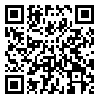مجله رویش روانشناسی از دادن گواهیهای کاغذی معذور است. لطفا تقاضا نکنید. همه گواهی ها در صفحه شخصی کاربران موجود است.
year 14, Issue 4 (sumer 2025 2025)
Rooyesh 2025, 14(4): 73-82 |
Back to browse issues page
Download citation:
BibTeX | RIS | EndNote | Medlars | ProCite | Reference Manager | RefWorks
Send citation to:



BibTeX | RIS | EndNote | Medlars | ProCite | Reference Manager | RefWorks
Send citation to:
Salami F, Jomehri F, Nasrollahi B, Noury R. (2025). Explaining the causal relationships between attachment styles and cyberbullying based on the mediating role of dark personality traits in adolescent social media users. Rooyesh. 14(4), 73-82.
URL: http://frooyesh.ir/article-1-5841-en.html
URL: http://frooyesh.ir/article-1-5841-en.html
1- Ph.D. Student of Department of Psychology, Science and Research Branch, Islamic Azad University, Tehran, Iran.
2- Assistant Professor, Department of Psychology, Faculty of Psychology and Education, Allameh Tabataba'i University, Tehran, Iran. ,farhadjomehri@yahoo.com
3- Assistant Professor, Department of Psychology, Science and Research Branch, Islamic Azad University, Tehran, Iran.
4- Associate Professor, Department of Clinical Psychology, Faculty of Psychology and Education, Kharazmi University, Tehran, Iran.
2- Assistant Professor, Department of Psychology, Faculty of Psychology and Education, Allameh Tabataba'i University, Tehran, Iran. ,
3- Assistant Professor, Department of Psychology, Science and Research Branch, Islamic Azad University, Tehran, Iran.
4- Associate Professor, Department of Clinical Psychology, Faculty of Psychology and Education, Kharazmi University, Tehran, Iran.
Abstract: (624 Views)
This research was conducted to examine the mediating role of dark personality traits in the relationship between attachment styles and cyberbullying among adolescent social media users. The present study was a descriptive-correlational research of the structural equation model type. The statistical population included all male and female students in Tehran's first and second stages of secondary education during the academic year 2023-2024. A cluster sampling method was employed to select 400 individuals who completed the questionnaires. The tools used in this research included the Cyberbullying- Victimization Experience Questionnaire (CBVEQ, Antoniadou et al., 2016), the Revised Adult Attachment Scale (RAAS, Collins & Read, 1990), and the Dark Triad Personality Traits Scale (DTDDS, Jonason & Webster, 2010). Data were analyzed using a structural equation model. The results of the structural equation model indicated a good fit for the model. The findings showed that secure and ambivalent attachment styles directly predicted cyberbullying (p<0.01). Additionally, secure, avoidant, and ambivalent attachment styles were able to indirectly predict cyberbullying through dark personality traits (p<0.01). These results suggest that attachment styles, considering the significant role of dark personality traits, can elucidate cyberbullying among adolescent users. Therefore, paying attention to these factors and their interactions in programs aimed at reducing cyberbullying is essential.
Type of Article: Research |
Subject:
General Psychology
Received: 2024/11/30 | Accepted: 2024/12/14 | ePublished: 2025/07/1
Received: 2024/11/30 | Accepted: 2024/12/14 | ePublished: 2025/07/1
Send email to the article author
| Rights and permissions | |
 |
This work is licensed under a Creative Commons Attribution-NonCommercial 4.0 International License. |





